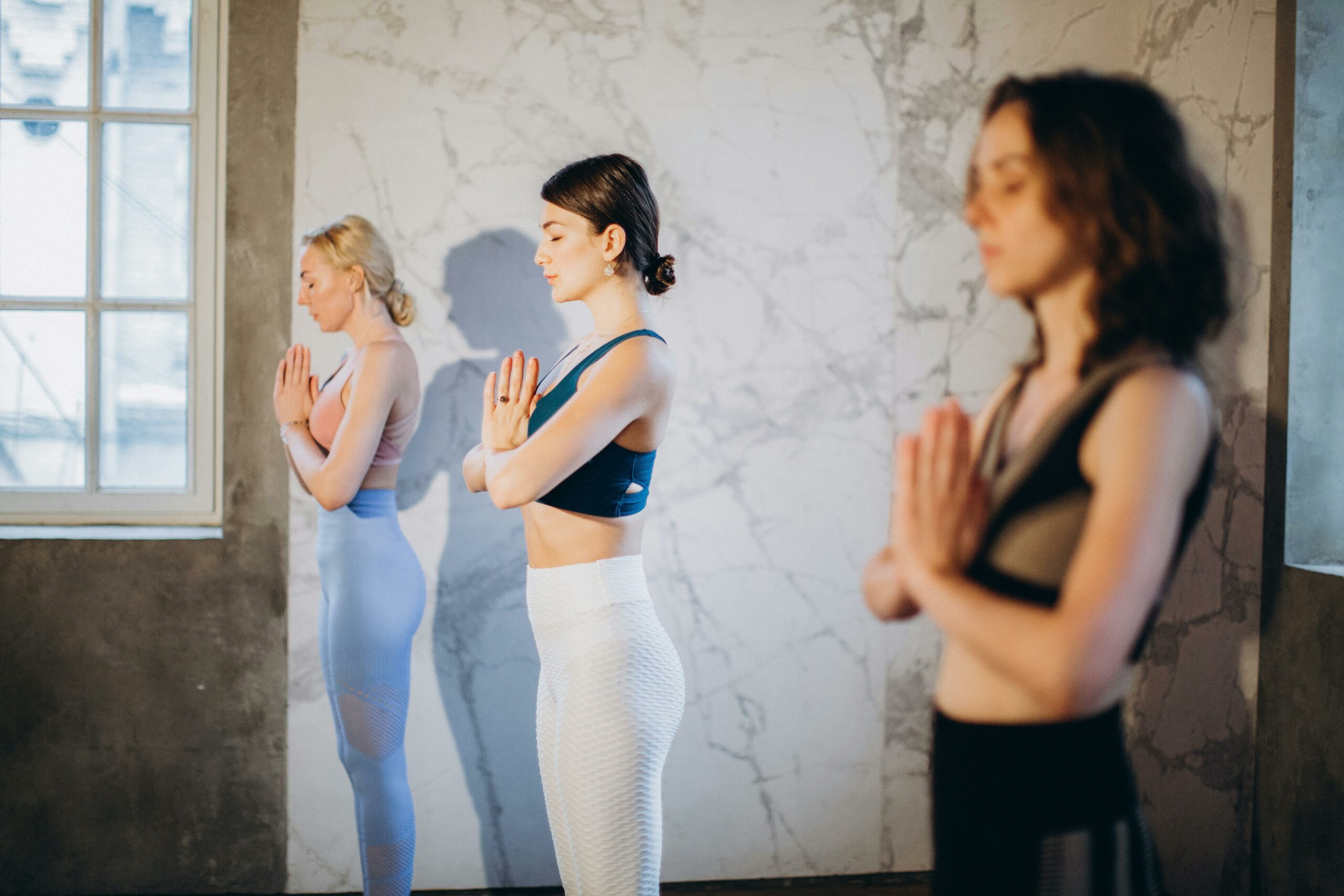Key Takeaway
Sun Salutations (Surya Namaskar) are a timeless yoga sequence that energizes the body, improves strength and flexibility, and can be a complete workout or a warm-up for a deeper practice.
If you’re looking for a quick yet invigorating yoga flow, a sun salutation sequence is essentially the OG morning yoga ritual.
The sun salutation, or surya namasakar, is one of the world’s oldest yoga sequences.
It likely dates back over 2,500 years!
It can take as little as 10 minutes and offers some impressive benefits. Better yet, it’s simple and easy to remember, so you don’t have to rely on a yoga class to get you on the mat.
Perfect for warming sleepy muscles in the morning, surya namaskara literally translates to “salute the sun”. Surya is Sanskrit for “sun” and is also the Hindu god as the sun.
Ancient sun-worshipping cultures performed the Surya namaskara sequence at sunrise to prepare the mind and body for all that the day would bring. And that was long before stressful office jobs and endless Zoom meetings!
Sun salutations are needed in the modern day more than ever.
Even with only 10 minutes of practice, this time-tested sequence is sure to quiet the mind and relax the body.
Here’s everything you need to know about how to do an energizing sun salutation flow, including a step-by-step guide to each posture.
Contents
- 1 What is a Sun Salutation (Surya Namaskar)?
- 2 Benefits of Surya Namaskar
- 3 What are the 12 Steps of Surya Namaskar?
- 3.1 Prayer Pose (Pranamasana)
- 3.2 Raised Arms Pose (Hasta Uttanasana)
- 3.3 Hand-to-Foot Pose (Hasta Padasana)
- 3.4 Equestrian Pose (Ashwa Sanchalanasana)
- 3.5 Plank Pose (Dandasana/Phalakasana)
- 3.6 Eight Limbed Pose (Ashtanga Namaskara)
- 3.7 Cobra Pose (Bhujangasana)
- 3.8 Downward Facing Dog (Adho Mukha Svanasana)
- 3.9 Equestrian Pose (Ashwa Sanchalanasana)
- 3.10 Hand-to-Foot Pose (Hasta Padasana)
- 3.11 Raised Arms Pose (Hasta Uttanasana)
- 3.12 Mountain Pose (Tadasana)
- 4 How many Surya Namaskars should be done in a day?
- 5 FAQs
What is a Sun Salutation (Surya Namaskar)?
If you’ve been practicing yoga for a while, you may be vaguely familiar with surya namaskar without even knowing it.
Variations of sun salutations are the hallmark of Vinyasa yoga classes where you use inhales and exhales to rhythmically transition from pose to pose with flowing movements.
The 12-pose sequence is a loop that lengthens and strengthens the body from all angles. Much like the sun, this beautiful sequence builds heat in the body and enlivens you with energy to bring into whatever is next.
Although there are a few versions of surya namaskara, the traditional “sun salutation” sequence will be used in this article. It is the most conventional variant and suitable for users of all skill levels.
If you have trouble memorizing the sequence or just prefer a nice visual on the wall of your yoga room, you may want to check out this illustrated sun flow wall art:
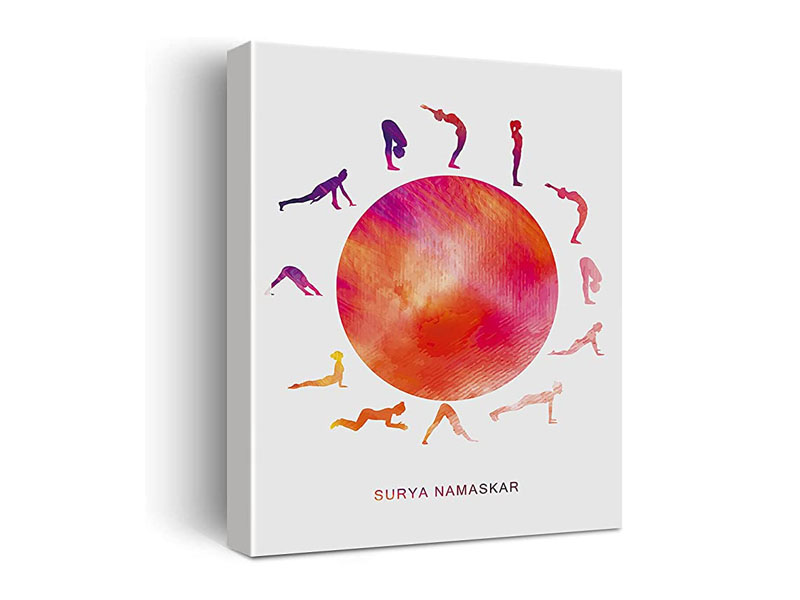
Benefits of Surya Namaskar
The traditional sun salutation sequence is designed to build heat in the body and act as a warm-up for meditation or a longer yoga flow.
It can also be used as a stand-alone practice to squeeze in between long periods of sitting. Think of it like your morning coffee or afternoon pick-me-up.
Sun salutation has a range of physical and mental health benefits:
- Boost energy
- Get a full-body workout
- Increased blood circulation
- Warm up muscles for more challenging poses
- Build muscle tone and strength
- Maintain a healthy lower back
- Stretch your legs and arms
- Improve posture
- Counteract the effects of a sedentary lifestyle
- Reduce stress
- Improve breath control
- Helps insomnia
- Aids in weight loss
It’s also a full-body workout! This ancient flow is also a great way to practice yoga for weight loss.
Thirty minutes of Surya Namaskar can torch over 400 calories, putting it up there alongside running and rock climbing in terms of hardcore exercise. Of course, this depends on how hard you push yourself and how many repetitions you do, but it’s a great reminder that yoga can be a sweaty workout that’s just as effective as hitting the gym.
But this flow is more than just physical exercise. Sun salutations can connect you with a deeper spiritual core by helping you quiet your mind and sync your body movements with your breath.
If you want to connect to the ancient yogic tradition, try practicing surya namaskar outdoors at sunrise. We speak from experience when we say it’s practically impossible to have a bad day if you start off flowing beneath the rising sun.
What are the 12 Steps of Surya Namaskar?
Sun salutation encompasses 7 asanas performed in a cyclical order to create 12 postures in total.
Prayer Pose (Pranamasana)
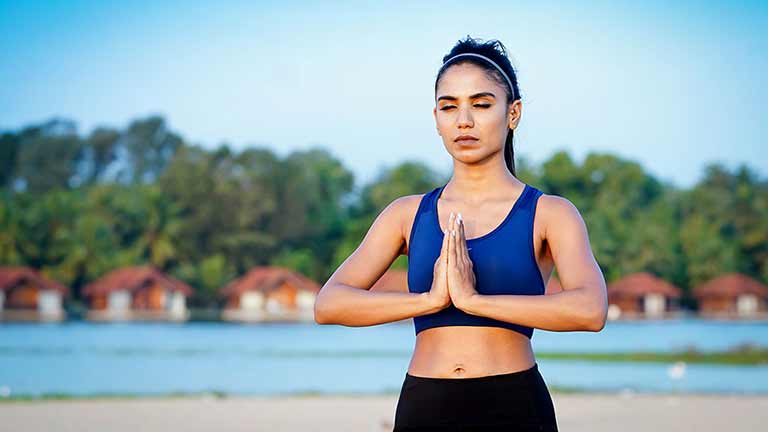
Surya namaskar begins in a variation of Mountain Pose with your hands at the heart center.
As you stand upright (ideally facing the rising sun), you begin by rooting your feet into the ground and calming your mind.
Keep your weight evenly distributed between your feet, ankles touching, and spine straight.
Find your center and bring your palms together in Anjali Mudra (also called namaste, or prayer hands).
Raised Arms Pose (Hasta Uttanasana)
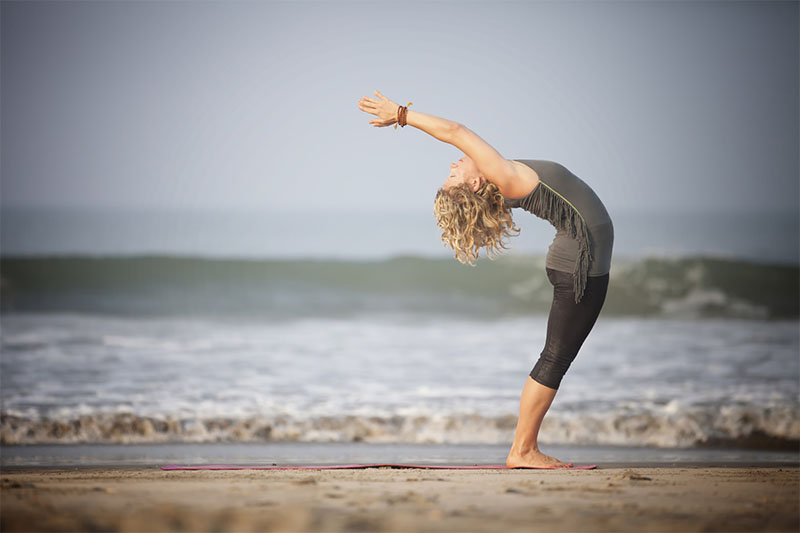
On an inhale, gradually lift your arms out to the sides and up above your head with your palms touching. Feel your heart opening as you reach in an upward salute to the sun.
Gaze slightly upward and add a slight backbend if you’d like, feeling your chest expand and your neck relax.
Hand-to-Foot Pose (Hasta Padasana)
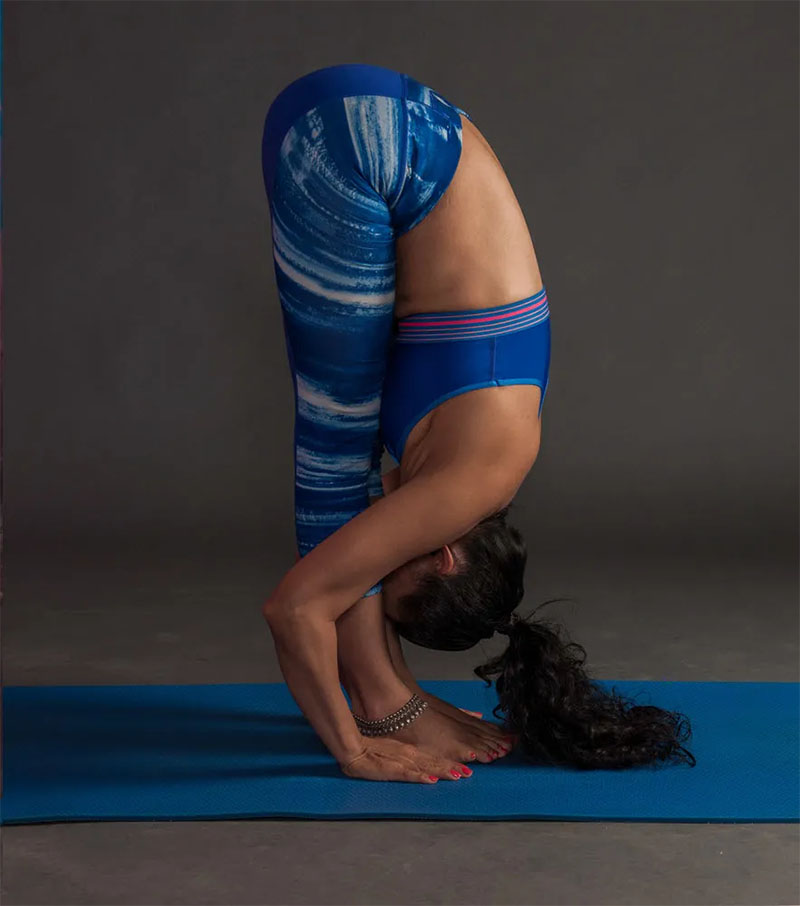
Slowly exhale your breath out as you fold forward at the hips into a standing forward bend. Feel your heart reach toward your thighs and keep your back straight, your core engaged.
Keep your legs strong and engaged by imagining your knees reaching toward your hips.
Release any tension in your neck and let your head dangle down toward the floor.
The hands can rest on knees, shins, blocks, or, if you’re flexible enough, directly on the floor.
If you aren’t quite ready for full forward folds, use yoga blocks or a strap to modify this pose. It is more important to keep your spine in a straight line than it is to reach the floor.
Feel the stretch in your hamstrings as your lower back lengthens and releases.
On an inhale, practice a halfway lift by keeping your back flat and your fingertips on the floor or your shins.
Equestrian Pose (Ashwa Sanchalanasana)
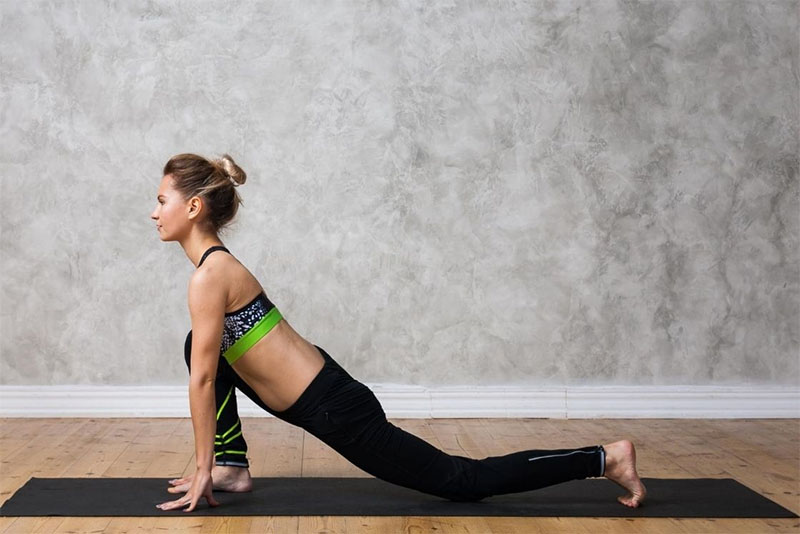
On the next exhale, place your hands flat on the mat and step back with the left foot into a low lunge. Keep the right foot forward, pressing into the floor.
Inhale as you broaden your chest forward and look slightly upward. Feel the opening in your hip flexors deepen the bend in the front knee. Your left hamstring will also stretch as you push the heel away from your body.
Pro Tip: Some variations move through this low lunge, while others skip it and go straight into plank pose. Add the Equestrian Pose/low lunge if you want added hip opening and leg strengthening. The choice is yours!
Plank Pose (Dandasana/Phalakasana)
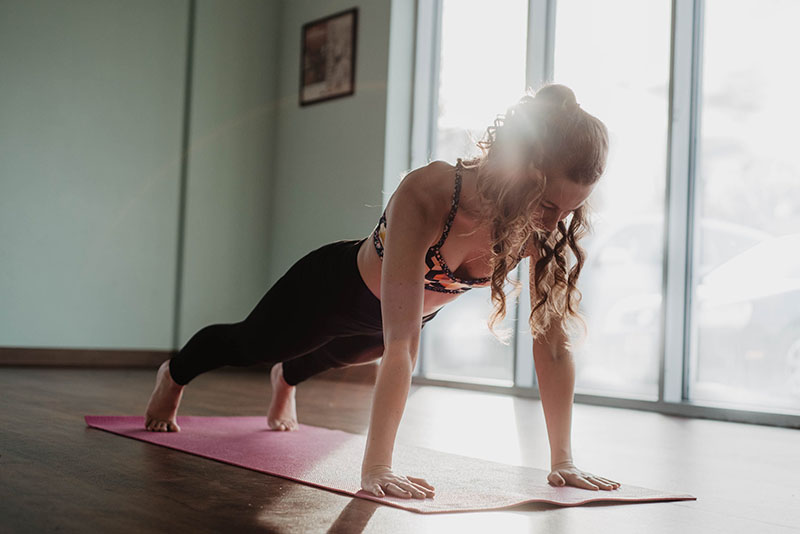
Exhale and step the right foot back to meet the left. Here, you will pause at the top of a push-up with your arms straight.
Make sure you are in proper alignment, with your shoulders stacked above your wrists and your feet hip-width apart.
Keep your core engaged and gaze down or slightly forward, keeping your neck long and straight.
Plank Pose is wonderful for improving core and arm strength. If needed, you can lower your knees to relieve any tension in your lower back.
Take a deep inhale and lengthen your back before moving into your low push-up.
Eight Limbed Pose (Ashtanga Namaskara)
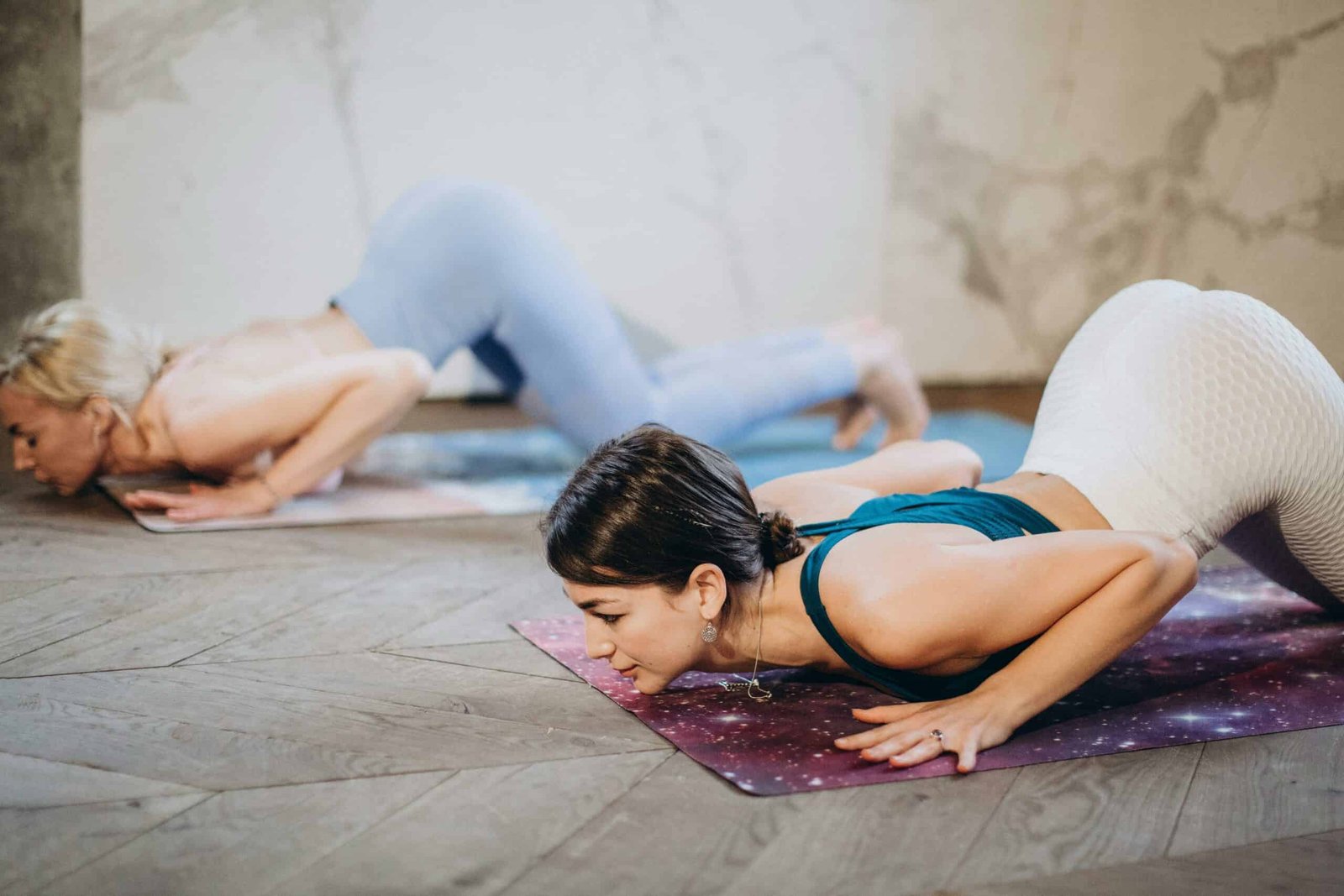
Bring your body down until it is parallel to the floor. Allow the two feet, the two knees, the two palms, the chest, and the chin to come into contact with the ground. The abdomen and hips are elevated slightly.
Breathing is interrupted for a few seconds while holding this stance, and is held outside.
Cobra Pose (Bhujangasana)
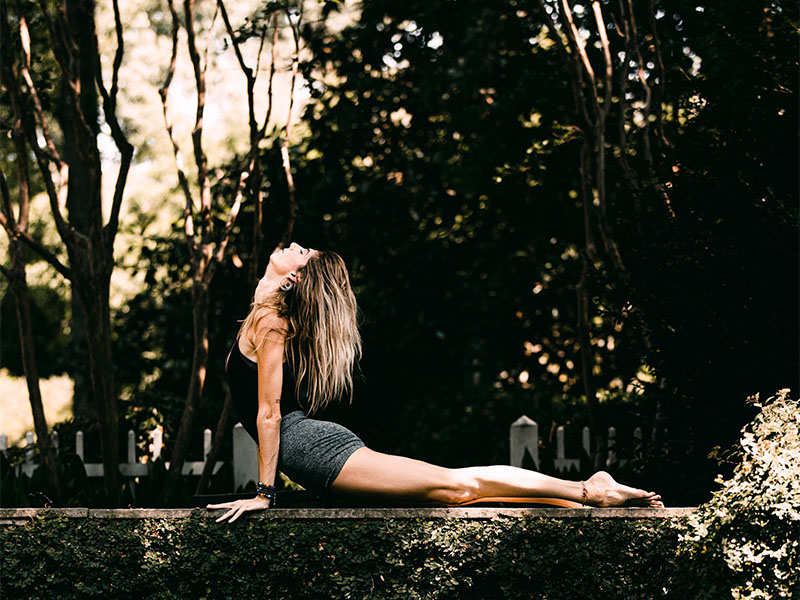
Some variations include a slow lowering of the chest to the floor and then lifting into Cobra Pose.
If you want to take this route, be sure to keep your elbows bent and hugging against your ribs. Feel your shoulder blades rolling back and down as you flex your arms and lift your chest forward. The tops of the thighs will simultaneously press into the ground.
Downward Facing Dog (Adho Mukha Svanasana)
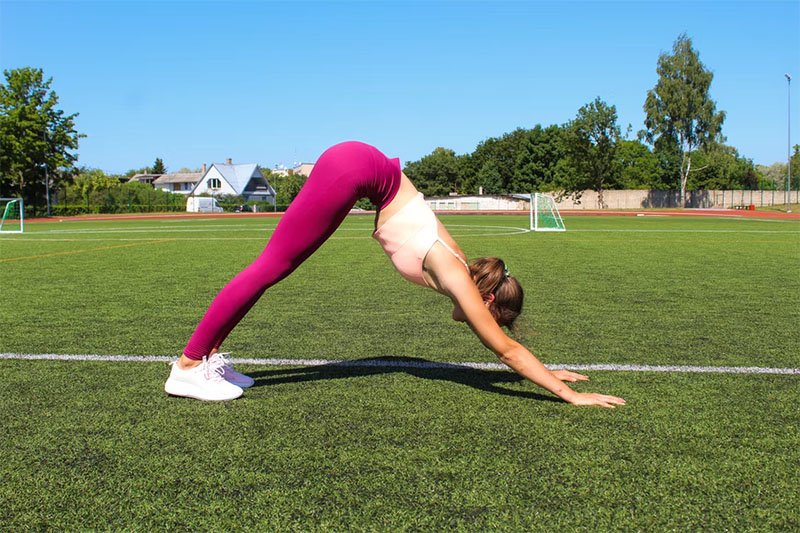
On the next exhale, lift your hips up and back into Downward Facing Dog pose. Press your heels down toward the ground as you lengthen your hamstrings deeper this time. But don’t worry if your heels don’t touch the mat! It’s the stretch that counts.
Try to spread your fingers wide and press through your knuckles for a firm grip on your yoga mat. Feel your spine straighten and lengthen as you relax your neck.
Hold Downward Facing Dog for a few deep breaths. Your body should be in an upside-down “V” shape. On each inhale, lengthen, and on each exhale, feel your chest sinking deeper back toward your thighs.
This is one of the best yoga poses for resting and recalibrating if the flow gets too intense for you.
Equestrian Pose (Ashwa Sanchalanasana)
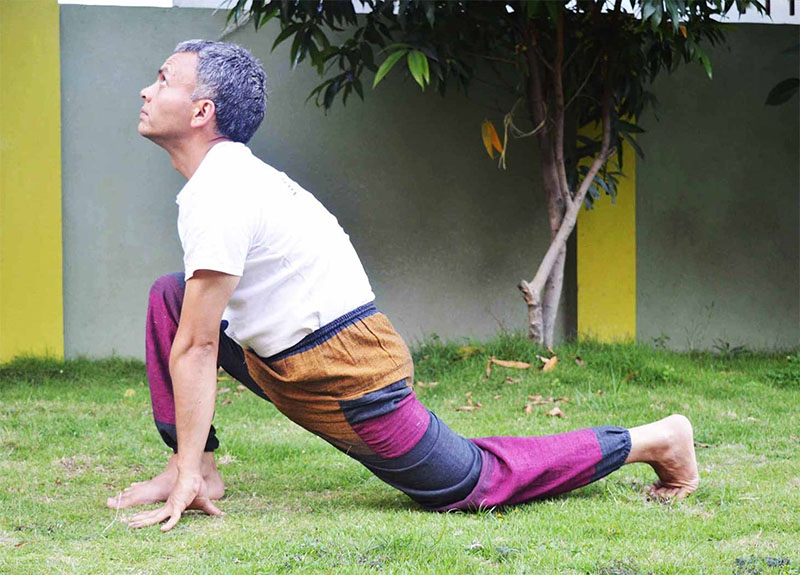
On the next inhale, step your left foot forward into a low lunge. The right leg should be stretched out and engaged behind you with the heel still lifted.
Hand-to-Foot Pose (Hasta Padasana)
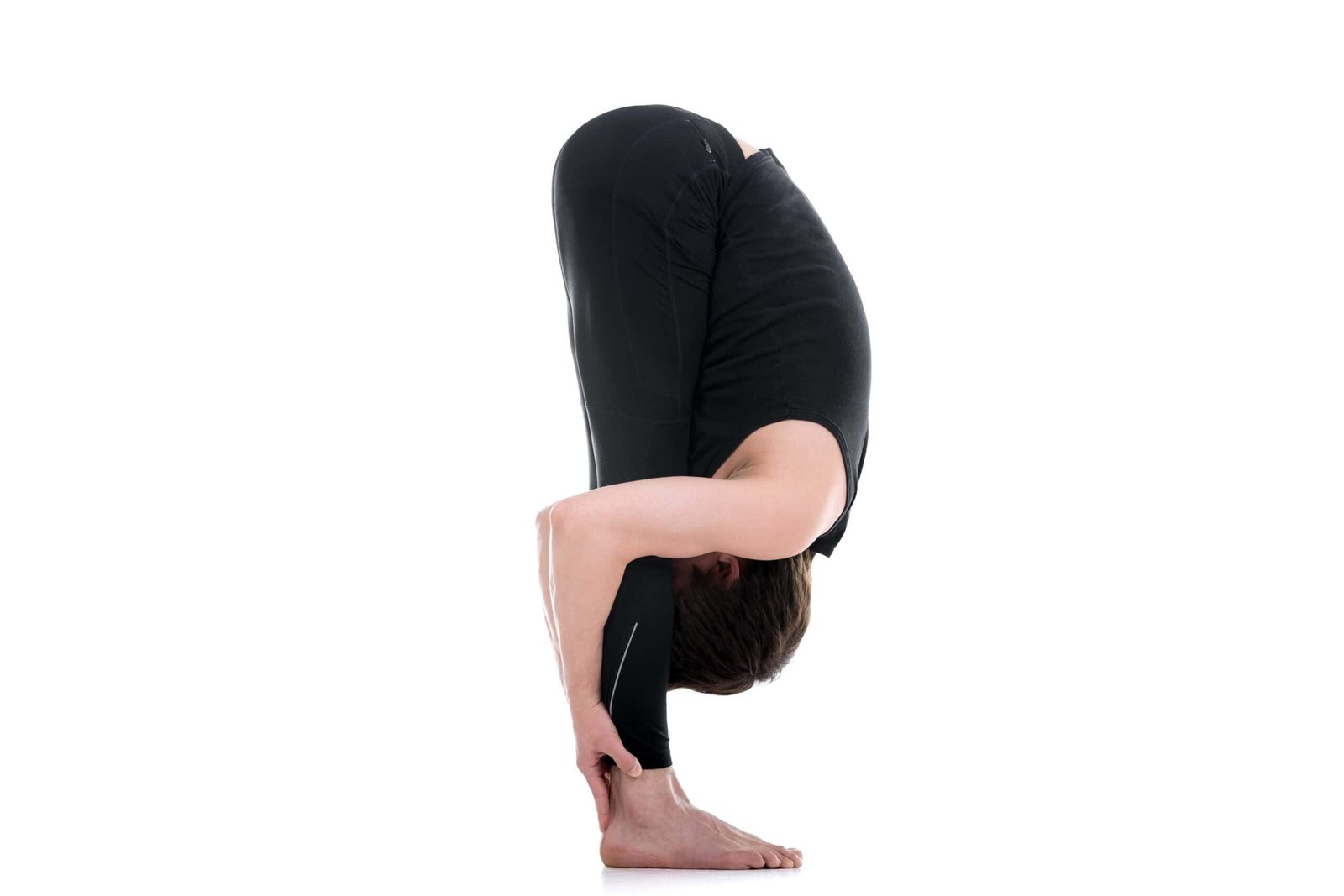
Exhale and step your right foot forward to return to a standing forward bend.
On the inhale, lift your chest halfway and straighten your back to enter the half-lift.
You can optionally return to a forward bend and hold for a few breaths to release the lower back and lengthen the hamstrings as you fold your torso closer to your legs.
Raised Arms Pose (Hasta Uttanasana)
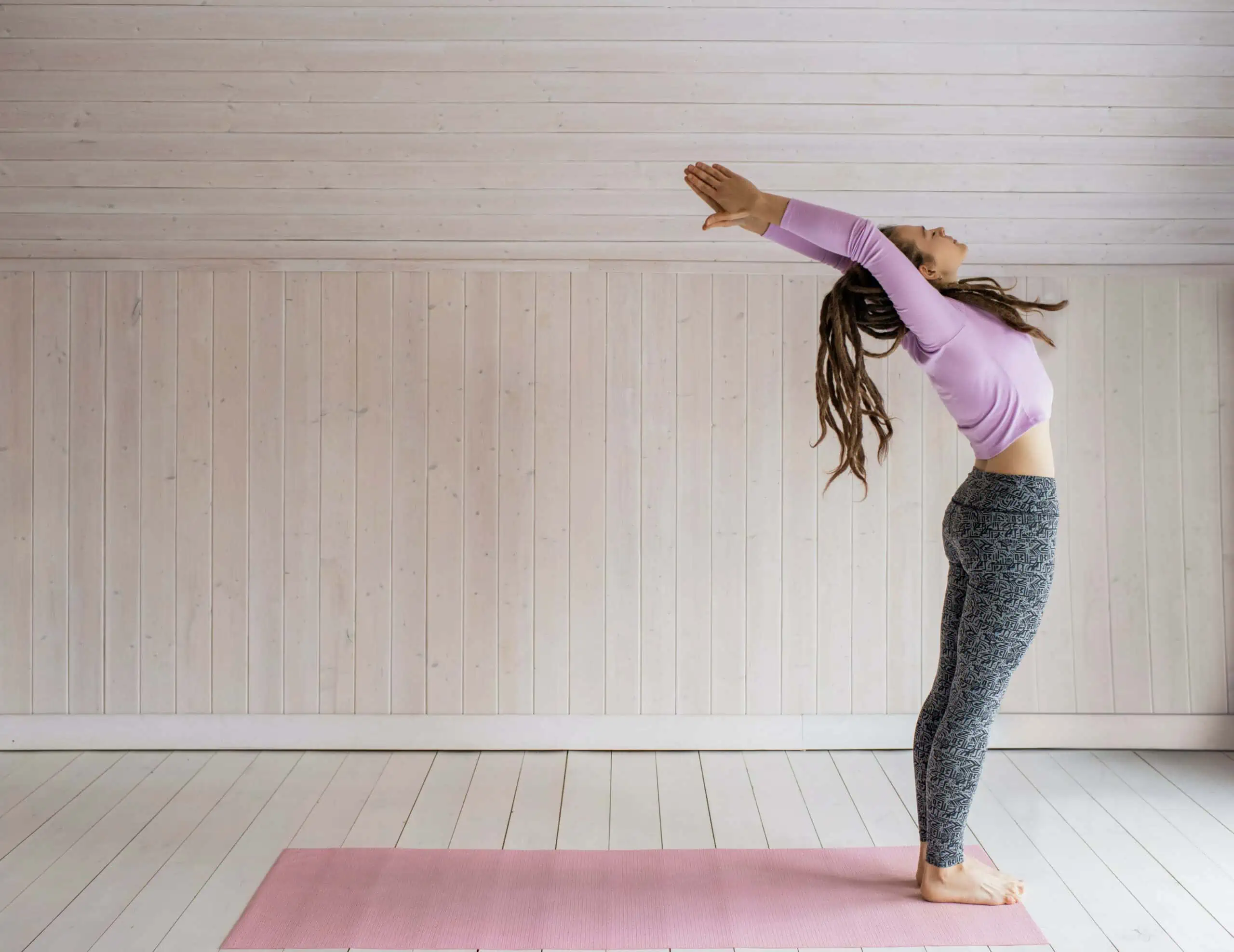
On an inhale, reach your arms straight out to your sides and then up overhead as you push through your legs to a standing position.
You can touch your palms together as you look up to the sky or, optionally, bring them through the heart center into the prayer position.
Mountain Pose (Tadasana)
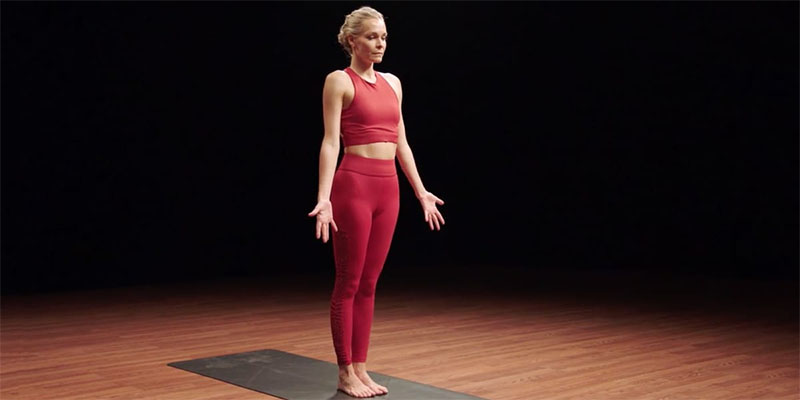
On an inhale, rise to mountain pose. You can bring your hands to the the the prayer position or keep the palms open to your side.
From here, you can repeat the sun salutation 2-12 times.
Depending on the intensity and duration of your yoga practice, you may wish to move at a more meditative pace or to make it a more cardio-intensive workout with quick-flowing movements.
Either way, don’t forget to sync your breath with each asana
How many Surya Namaskars should be done in a day?
For beginner yogis, even just one sun salutation is beneficial. More advanced yogis prefer to do 9–12 sets in a single asana practice.
Sun salutations can be repeated up to 108 times a day by advanced practitioners (108 is an important yoga symbol that represents spiritual completion). 9 sets of the 12 sun salutation postures also total 108.
To reap the best results, practice sun salutations consistently every day. You may start to notice that your downward dog deepens, your high plank gets stronger, your Chaturanga gets easier, and your breath becomes more free-flowing.
FAQs
What happens if you do Surya Namaskar every day?
Practicing sun salutations daily can help you enjoy tremendous physical benefits as well as spiritual balance. You will gain more flexibility, strength, focus, and range of motion. At the same time, you may experience better digestion, reduced stress, and a greater sense of peace.
What is a full Sun Salutation?
A full-sun salutation incorporates 12 yoga asanas that start and end at Mountain Pose. The sequence involves deep pranayama breathing that aims to sync inhales and exhales with specific bodily movements. As one becomes more familiar with surya namaskar, one can experience a meditative flow between postures that is reminiscent of a dance to the rhythm of your breath.
How many times should you do a Sun Salutation?
Sun salutation can be practiced anywhere from 1 to 108 sets at a time. However, the most realistic and popular number of repetitions is 9. Doing 9 rounds of the 12 postures results in the holy number 108, which coincides with the number of beads on a mala meditation necklace.


